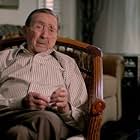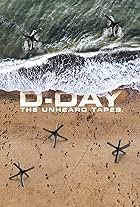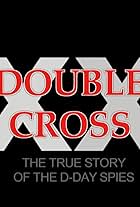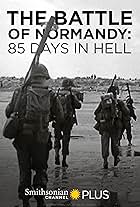An examination of how two years of planning, espionage and analysis helped the Allied Forces win D-DayAn examination of how two years of planning, espionage and analysis helped the Allied Forces win D-DayAn examination of how two years of planning, espionage and analysis helped the Allied Forces win D-Day
- Awards
- 1 win
Browse episodes
Storyline
Did you know
- TriviaThe map displayed eight minutes into Part 1 uses post-1945 borders to illustrate Germany's 1939 invasion of Poland. The land identified as Poland was actually German Prussia, which was forcibly ceded to Poland in 1947 as compensation for territory seized by the Soviet Union while allied with the Nazis under the Molotov-Ribbentrop Pact.
Featured review
For those too young to have experienced the events at first-hand, the D-Day landings of 6 June 1944 have become the stuff of legend, an epic - and ultimately successful - attempt by the Allied forces to re- take northern France and hence begin the process of liberating Europe from Nazi occupation. Darryl F. Zanuck's memorable film THE LONGEST DAY (1962) has proved highly influential in this mythologization process, with its portrayal of heroism under extreme conditions.
In this three-part documentary Dan Snow uses a combination of archive photographs - taken by reconnaissance planes, computer- generated maps, reminiscences and location filming - to give the story far more light and shade than in the past. Following a disastrous attempt to re- take Dieppe in 1942, when a combination of bad planning and intelligence led to numerous casualties and a failed mission, the Allies spent some considerable time planning the D-Day landings. The reconnaissance photos were taken to an air base outside London, where they were minutely scrutinized by a bevy of specialists in order to determine precisely what kind of defenses the Nazis had constructed in France. The photos also revealed the best possible positions where a landing might be initiated.
A huge force was assembled of Allied troops - the largest invasion in history in terms of numbers - but the soldiers were told little or nothing of what was about to happen until one or two days beforehand. The generals were leaving nothing to chance: the Nazis should not find out anything if it could be possibly avoided. The British and Commonwealth forces were due to attack three beaches; the US Army were attacking two others.
On 6 June 1944 the offensive began. At one beach (code-named Omaha), the Americans suffered heavy casualties; it was only due to the bravery of one group of Rangers that the position was captured. Resistance was less stern on the beaches captured by the British; the advance forward was both speedy and efficient towards the city of Caen, designated as one of the first major strategic positions to recapture.
Snow is an effective guide to events. As he walks across some of the beaches, with the remains of Nazi defenses still visible even after seventy years, we understand precisely how dangerous the operation actually was: many of the Allied troops were simply mowed down by German machine-guns in open country. It was expected that the casualty-rate would be over fifty per cent. Some of the soldiers interviewed - now in their eighties or nineties - still find the experience difficult to talk about, as their buddies were cut down in the prime of life. The offensive might have been a success, signaling the turn of fortunes that led to the end of World War Two in May 1945, but it was still a highly dangerous and complex operation in which no one expected to come out alive.
D-DAY: THE LAST HEROES is the kind of documentary series that the BBC do really well - both well-written and constructed, it not only redefined our understanding of a major event in twentieth century history, but made us appreciate the contribution of those unsung heroes (the soldiers) that ensured its ultimate success.
In this three-part documentary Dan Snow uses a combination of archive photographs - taken by reconnaissance planes, computer- generated maps, reminiscences and location filming - to give the story far more light and shade than in the past. Following a disastrous attempt to re- take Dieppe in 1942, when a combination of bad planning and intelligence led to numerous casualties and a failed mission, the Allies spent some considerable time planning the D-Day landings. The reconnaissance photos were taken to an air base outside London, where they were minutely scrutinized by a bevy of specialists in order to determine precisely what kind of defenses the Nazis had constructed in France. The photos also revealed the best possible positions where a landing might be initiated.
A huge force was assembled of Allied troops - the largest invasion in history in terms of numbers - but the soldiers were told little or nothing of what was about to happen until one or two days beforehand. The generals were leaving nothing to chance: the Nazis should not find out anything if it could be possibly avoided. The British and Commonwealth forces were due to attack three beaches; the US Army were attacking two others.
On 6 June 1944 the offensive began. At one beach (code-named Omaha), the Americans suffered heavy casualties; it was only due to the bravery of one group of Rangers that the position was captured. Resistance was less stern on the beaches captured by the British; the advance forward was both speedy and efficient towards the city of Caen, designated as one of the first major strategic positions to recapture.
Snow is an effective guide to events. As he walks across some of the beaches, with the remains of Nazi defenses still visible even after seventy years, we understand precisely how dangerous the operation actually was: many of the Allied troops were simply mowed down by German machine-guns in open country. It was expected that the casualty-rate would be over fifty per cent. Some of the soldiers interviewed - now in their eighties or nineties - still find the experience difficult to talk about, as their buddies were cut down in the prime of life. The offensive might have been a success, signaling the turn of fortunes that led to the end of World War Two in May 1945, but it was still a highly dangerous and complex operation in which no one expected to come out alive.
D-DAY: THE LAST HEROES is the kind of documentary series that the BBC do really well - both well-written and constructed, it not only redefined our understanding of a major event in twentieth century history, but made us appreciate the contribution of those unsung heroes (the soldiers) that ensured its ultimate success.
- l_rawjalaurence
- Dec 3, 2014
- Permalink
Details
- Release date
- Country of origin
- Official site
- Language
- Also known as
- Hjältarna från Dagen D
- Production company
- See more company credits at IMDbPro
Contribute to this page
Suggest an edit or add missing content

Top Gap
By what name was D-Day: The Last Heroes (2013) officially released in Canada in English?
Answer
















